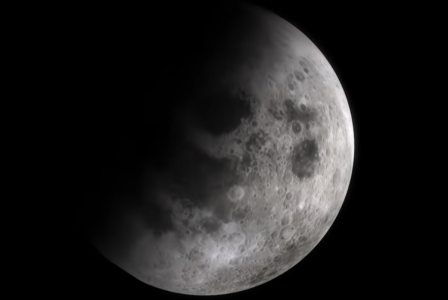A mysterious lunar event is coming soon, and it’s stirring up conversation
By
Veronica E.
- Replies 0
If you’ve seen talk online about a mysterious “black moon” and wondered if it’s a sign of something bigger, you’re not alone.
Social media is buzzing with theories, ranging from scientific explanations to apocalyptic warnings.
Some posts even tie the event to biblical passages, fueling speculation about what it all means.
But before you start worrying, astronomers say there’s nothing unusual or alarming about this lunar phenomenon.
In fact, it’s a simple quirk of the calendar that offers an excellent opportunity for stargazing.

Despite the ominous name, “black moon” isn’t an official astronomical term.
It’s a nickname used when two new moons occur within the same calendar month—a relatively rare event that happens roughly once every 33 months.
A new moon occurs when the moon passes between Earth and the sun, leaving the side we see in complete shadow.
This month, the second new moon falls on Saturday, August 23, at 11:06 p.m. PDT, which means just after midnight on the East Coast.
While the moon itself won’t be visible, its absence creates darker skies.
Part of the fascination comes from the rarity—two new moons in one month don’t happen often.
But the hype is also fueled by online chatter, where some people connect the event to doomsday prophecies or biblical references about the moon losing its light.
Scientists, however, are clear: this is not a supernatural sign.
It’s just a natural part of the moon’s cycle aligning with how we keep time on our calendars.
Walter Freeman, associate teaching professor of physics at Syracuse University, explains it simply: “A black moon is just a second new moon that happens in one calendar month. From a scientific perspective, this is no different than any other new moon.”
In other words, the black moon isn’t about cosmic change—it’s about how our human calendar lines up with lunar cycles.
Even though you won’t see the moon itself, the black moon creates perfect conditions for observing the night sky.
With no moonlight to wash things out, stars, planets, and even the Milky Way will appear clearer and brighter.
Professor Freeman encourages anyone with an interest in astronomy to take advantage: “The lack of moonlight makes for perfect stargazing conditions.”
Whether you use a telescope or just your eyes, it’s an ideal time to enjoy the view.
Throughout history, lunar events have held symbolic importance.
While full moons are often linked with celebrations and folklore, the new moon is sometimes seen as a moment for reflection and new beginnings.
In that sense, a black moon is simply an extra chance within the month to pause, reset, and look ahead.
If you miss this black moon, you’ll have to wait until August 20, 2028 for the next one.
These events aren’t frequent, which is part of what makes them so intriguing.
The black moon may not bring dramatic signs or celestial warnings, but it does offer something far more meaningful—a chance to pause, look up, and reconnect with the wonder of the night sky.
Whether you see it as a moment for reflection, a treat for stargazers, or just an interesting quirk of the calendar, it’s a reminder of how much there is to discover above us.
Read next: A NASA intern stole moon rocks worth $21 million—the shocking details revealed

Do you plan on stargazing during the black moon? Have you experienced other rare sky events like eclipses or meteor showers? Share your stories and tips in the comments—we’d love to hear how you enjoy the night sky!
Social media is buzzing with theories, ranging from scientific explanations to apocalyptic warnings.
Some posts even tie the event to biblical passages, fueling speculation about what it all means.
But before you start worrying, astronomers say there’s nothing unusual or alarming about this lunar phenomenon.
In fact, it’s a simple quirk of the calendar that offers an excellent opportunity for stargazing.

The rare “black moon” offers darker skies and perfect conditions for stargazing this weekend. Image Source: YouTube / WION.
What is a black moon?
Despite the ominous name, “black moon” isn’t an official astronomical term.
It’s a nickname used when two new moons occur within the same calendar month—a relatively rare event that happens roughly once every 33 months.
A new moon occurs when the moon passes between Earth and the sun, leaving the side we see in complete shadow.
This month, the second new moon falls on Saturday, August 23, at 11:06 p.m. PDT, which means just after midnight on the East Coast.
While the moon itself won’t be visible, its absence creates darker skies.
Also read: From zero gravity to hard reality: NASA astronauts face new challenges on Earth
Why all the attention?
Part of the fascination comes from the rarity—two new moons in one month don’t happen often.
But the hype is also fueled by online chatter, where some people connect the event to doomsday prophecies or biblical references about the moon losing its light.
Scientists, however, are clear: this is not a supernatural sign.
It’s just a natural part of the moon’s cycle aligning with how we keep time on our calendars.
Also read: This man wrote his own goodbye—Prepare for tears of pain…and joy?
What scientists say
Walter Freeman, associate teaching professor of physics at Syracuse University, explains it simply: “A black moon is just a second new moon that happens in one calendar month. From a scientific perspective, this is no different than any other new moon.”
In other words, the black moon isn’t about cosmic change—it’s about how our human calendar lines up with lunar cycles.
Also read: NASA’s latest Mars find sparks new questions about ancient life
Why it’s great news for stargazers
Even though you won’t see the moon itself, the black moon creates perfect conditions for observing the night sky.
With no moonlight to wash things out, stars, planets, and even the Milky Way will appear clearer and brighter.
Professor Freeman encourages anyone with an interest in astronomy to take advantage: “The lack of moonlight makes for perfect stargazing conditions.”
Whether you use a telescope or just your eyes, it’s an ideal time to enjoy the view.
Also read: 2025 must-know dates: Don’t miss these key moments!
Cultural meaning of the new moon
Throughout history, lunar events have held symbolic importance.
While full moons are often linked with celebrations and folklore, the new moon is sometimes seen as a moment for reflection and new beginnings.
In that sense, a black moon is simply an extra chance within the month to pause, reset, and look ahead.
Also read: The Dark Side Of The Moon
When’s the next one?
If you miss this black moon, you’ll have to wait until August 20, 2028 for the next one.
These events aren’t frequent, which is part of what makes them so intriguing.
The black moon may not bring dramatic signs or celestial warnings, but it does offer something far more meaningful—a chance to pause, look up, and reconnect with the wonder of the night sky.
Whether you see it as a moment for reflection, a treat for stargazers, or just an interesting quirk of the calendar, it’s a reminder of how much there is to discover above us.
Read next: A NASA intern stole moon rocks worth $21 million—the shocking details revealed
Key Takeaways
- A “black moon” occurs when two new moons fall within the same calendar month, a rare event that happens about once every 33 months.
- The upcoming black moon will occur on Saturday, August 23, peaking at 11:06 p.m. PDT, or just after midnight on the East Coast.
- While the moon won’t be visible, darker skies will make stargazing conditions especially good for spotting stars, planets, and the Milky Way.
- Despite some online speculation, astronomers emphasize that the black moon is not a supernatural or apocalyptic sign.
Do you plan on stargazing during the black moon? Have you experienced other rare sky events like eclipses or meteor showers? Share your stories and tips in the comments—we’d love to hear how you enjoy the night sky!






